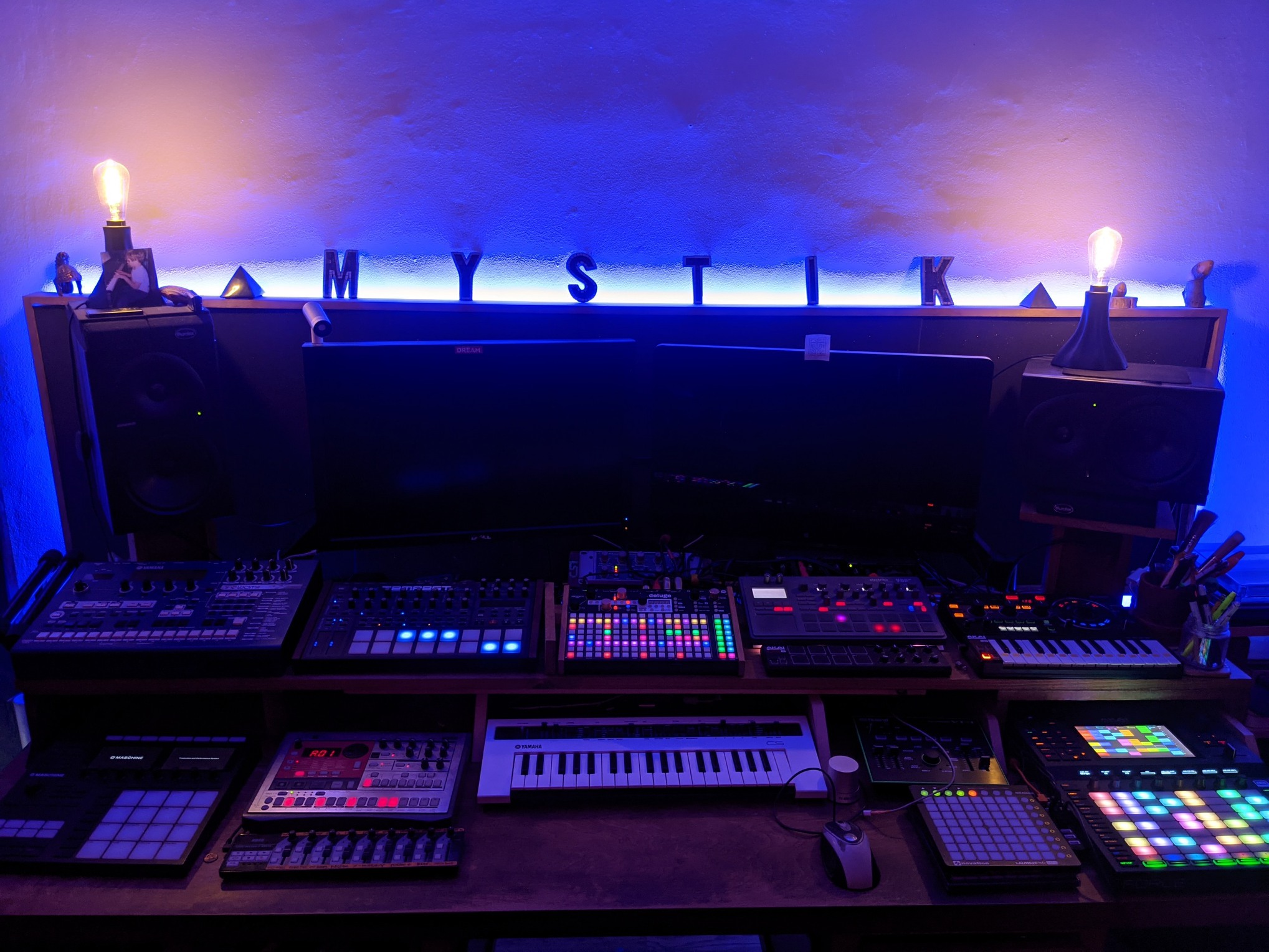
All of them! LOL! But, keep reading if you want to know which one individually takes the crown. Also, let’s all acknowledge this is totally subjective. Everyone will have their own experiences. These are obviously insights drawn from my experiences. They’re based on a bunch of criteria, mostly use cases. Actual use cases, tangible experience and general utility as well as looking at the overall facility as an “all-in-one production” studio.
Here are some of the primary criteria we’ll be looking at in broad strokes.
- Controls / Knobs
- Synths
- Drums
- FX
- Modulation
- Arranger
- Song Mode
- Track Count
- I/0
- Pros
- Cons
- Summary
Ok, so there have definitely been great reviews out there exploring this topic and there are definitely several contenders that I’m personally going to be comparing and contrasting a bit in this post, based on my own past – and current – experience with the gear I’m about to mention.
First, to name a few of the pieces I can discuss with any authority or expertise. That’s really the only way the info I’ll present is going to be valuable. I can’t speak to something I haven’t used or don’t own or if I don’t know the workflow.
So, In order of appearance, in my history and studio experience. (Some titles link down to respective sections…)
- Korg ER1
- Boss Dr. Groove Drum Machine
- Roland SP808 (sampler, not really a groovebox)
- Yamaha RM1X/RS7000
- Korg Electribe 2
- Synthstrom Deluge
- Dave Smith Instruments & Roger Linn Tempest
- Akai Force
- Native Instruments Maschine (*note I have an MK3, not the Maschine+, but can review the common feature set)
Each of the units listed above has been a fairly formative piece of hardware for me at some point in my trajectory. Obviously as newer gear became available and I was able to obtain or purchase it, I went that road as I have been trying to tie things in together, the workflow and production aspect of creating scenes and then using some kind of song mode to progress between them, with the ability to use automations, effects, modulation and adjust channel parameters.
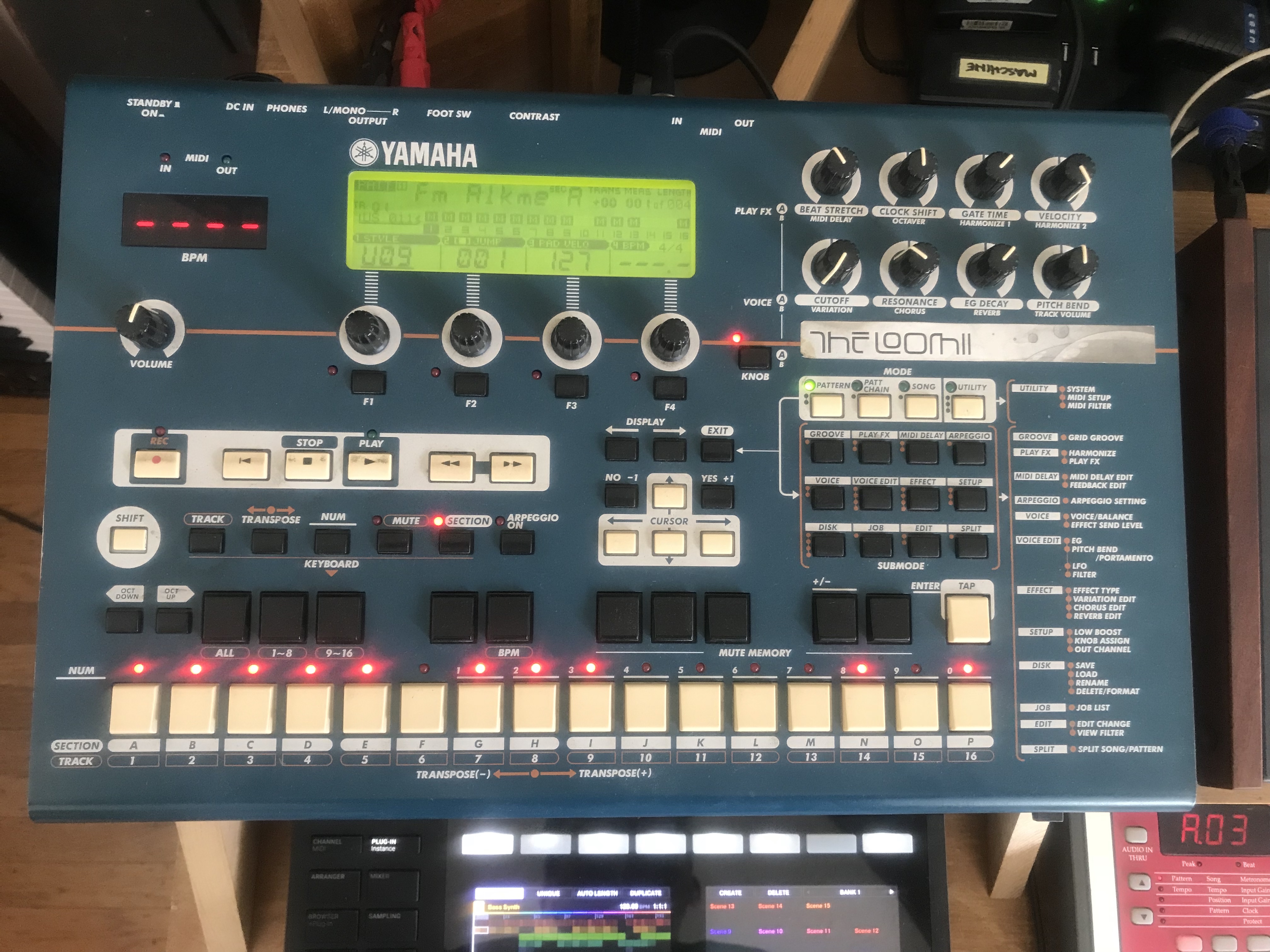
Yamaha RM1X
Pros
- 16 voices/tracks
- 16 sections
- Lots of onboard voices
- Powerful sequencer
- Grid Groove
- Song stays in memory through power cycles
Cons
- Limited sound sculpting abilities
- No high-pass filter
- No onboard compressor
- A bit menu heavy for functions. Shortcuts help.
- Floppy disk era, no USB
- No beat-synced delay
- No front-panel LFO controls (also didn’t use the LFO on this as much as the RS7000 which was fantastic)
I’ll be honest until the Yamaha RM1X, which was a part of my “original rig” back in the day…working with my brother on The Loomii project in West Oakland, the Boss DR-202 “Dr. Groove” drum machine and Roland SP808 sampler didn’t have enough going for them to really constitute a serious contender.
However, once the RM1X came into the picture, it brought 16 tracks, with its own set of onboard drum kits and synth voices, a few effects (not bpm synced – more on this later) and a good loop sequencer and phrase system for composing and jamming with pattern based material. It did have a song mode, but honestly, I never figured it out. We were always jamming live and arranging everything on the fly. Frankly I don’t think I had even figured out scenes back then too well.
Still with the RM1X, once we had our first set, I brought that up to Tahoe with me for a weekend of solitude while my then girlfriend went snowboarding and ended up writing the core of our first Loomii set, which we performed at my then girlfriend’s birthday party at 111 Minna in San Francisco, constituting our very first set in SF as The Loomii at a notorious club.
After the RM1X, my brother Dave got the RS7000. That is a powerhouse. Honestly, its got a huge set of improvements like an LFO with controls on the panel, a high pass filter (which was great), sampler, 2 velocity sensitive “drum” or “sample” pads, master effects with a bunch of cool options. Dave used it (and still owns it) for years in our rigs for The Loomii.
Working for myself at the time (still, too) I had a fairly limited budget for new gear. I was fortunate my brother sold me (I believe) the RM1X) which I continued to use for a long time as the centerpiece of my rig.
I love this unit. I still use it to this day for some basslines, it has a nice arpeggio function, transpose feature, loads of phrases to use, some decent controls… The SynthBass&Lead “Funk Bass” is one of my go-to bass voice presets. Also the scenes are definitely useful. Maybe my first groovebox love.
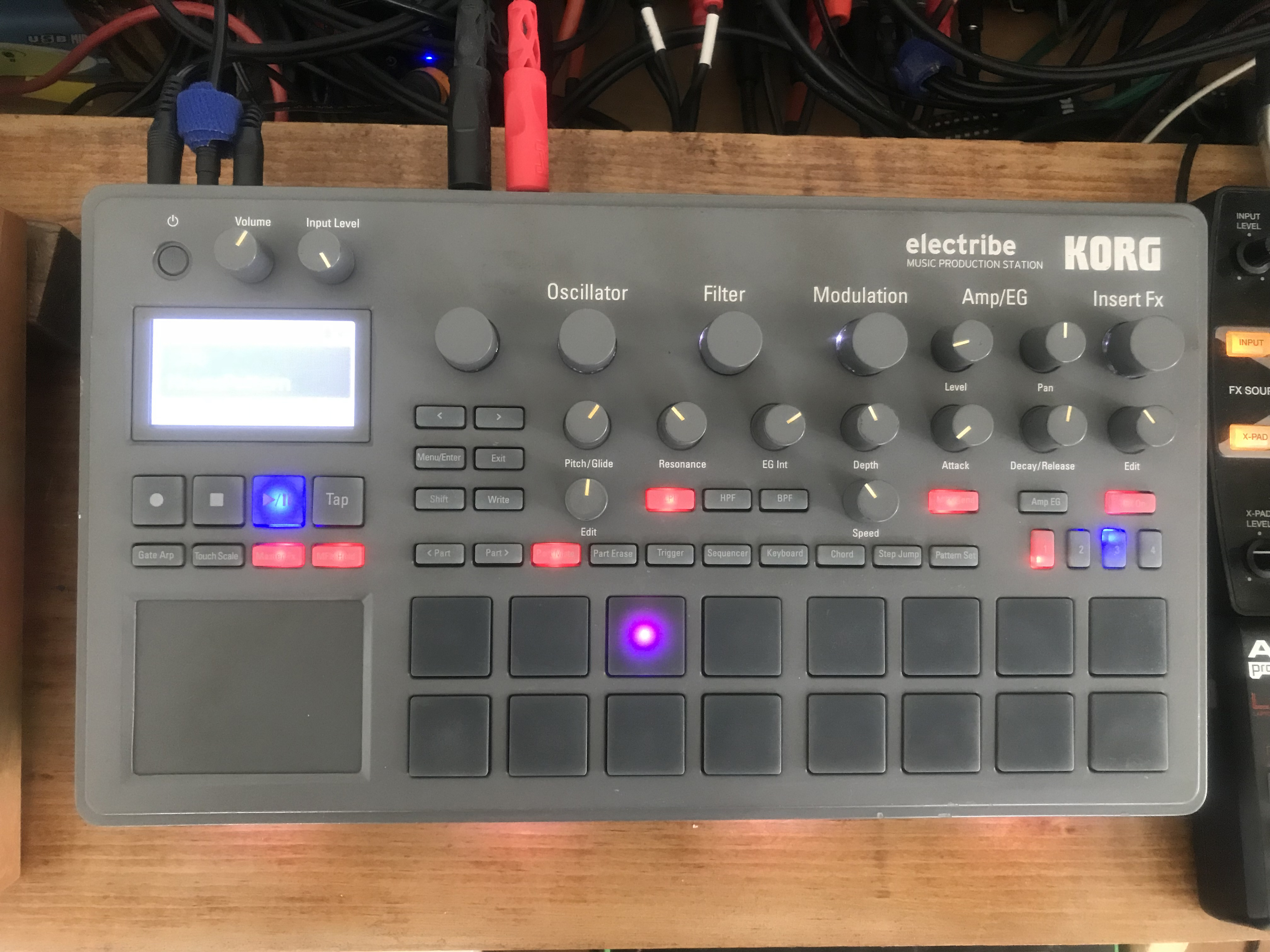
Korg Electribe 2
Pros
- 16 voices/tracks
- 64 quick access patterns
- Good variety of synth waves & sounds (408 with 409 used as an audio in/thru)
- High pass filter included
- Master Compressor & channel effect limiters
- Wet Reverb
Cons
- 1 “section” per “project”
- Color scheme
- Lack of labels, functions and shortcuts are obscure
- Song does not stay in memory through power cycles
- Naming & versioning is rigid & tedious
When the Electribe 2 came out, i wanted one instantly. I had been trying to piece together a similar instrument using all 3 nano korg controllers as an outboard control system for Ableton Live. The Electribe 2 unified that control system into its own standalone unit, with “all the voices of the King Korg” from what i hear… it does have good synthesis options. loads of voices to start with. Also it has some nice and punchy kicks which were missing from the RM1X (which only had a few I’d use regularly)…and brought in the ability to switch the main filter from HPF to LPF and BPF, with the ability to add a second filter (LPF or HPF only) as a channel effect. It also unified the X/Y pad as a controller for the master effects, also a “nice touch” pun intended. I had been using the pad controller with the X/Y to control my reverb which was all built in using the Wet Reverb and the X/Y pad on the Electribe 2. Great stuff.
The Korgs also have the ability to motion record on the patterns which is a quick way to add automation to various parameters via knob twists or X/Y pad movements.
One thing I appreciated about the Yamaha RM1X is the way it remembers what you have in it’s internal RAM or memory, even between power cycles. With the Korg, I have to save the pattern before i switch it or power it down, which makes it a bit more fragile of a system to me, as I sometimes hit the wrong knob to adjust oscillators and instead, accidentally, will hit the knob to switch patterns instead! Yikes! i need a custom knob there with a different color. I tried getting one but the company had stopped offering them online and I’m not sure where to get them (not chromacaps, the official korg electribe 2 knobs in different factory colors, black, blue/silver, red/silver, grey…). But I digress.
The Korg is a powerful unit, I won’t deny. Having seen guys like Mistabishi use it and create amazing music, very dynamic and evolving – and also created my own mini sets at times… I know it is a powerful unit. For some reason, I’ve only used the last 50 user presets, keeping the factory presets, just in case. I suppose i could always try to restore them or save my patterns to an SD card, but I’ve been keeping it to those last 50 presets. Which feels a bit limiting. I’ve filled those all and continue using them as they’re mostly keyed and I’m using the unit for percussive elements mostly these days, not so much leads or synths anymore. There was a time, however, when it was my newest box, offering the punchier kicks, still giving me 16 tracks, smaller, had high pass filters, even channel based limiters and a compressor on the master effect…nice wet reverb, all those King Korg synth voices… That was it then. I was using it for synth leads, pads, basslines, drums, effects…everything too… mostly using it to record however. Because I was limiting myself to those last 50 tracks, I never really evolved into using 3 or 4 patterns per “song,” which, from listening to the factory presets, is a nice way to compose the various sections of the track…at least using the Electribe 2.
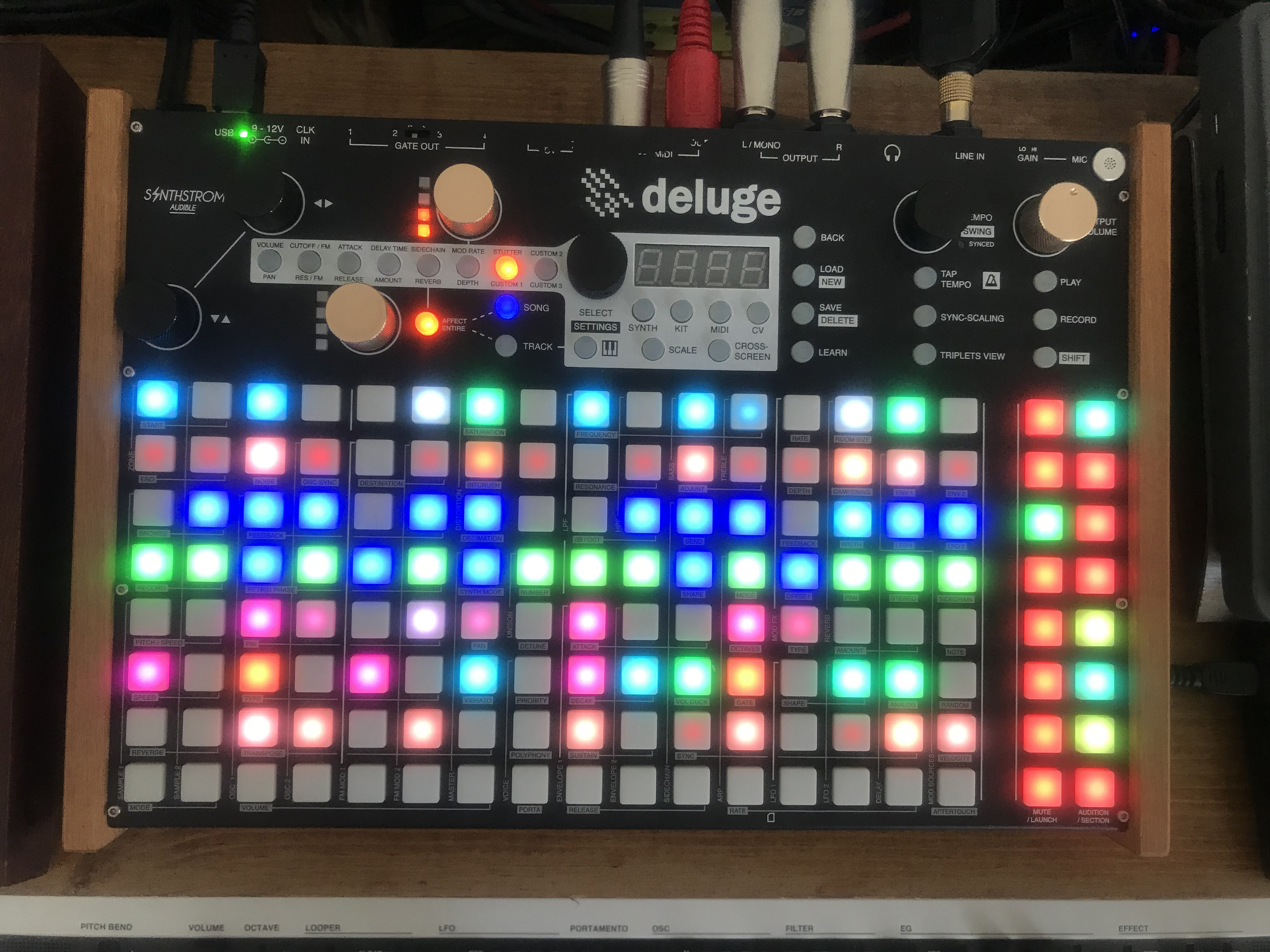
Synthstrom Deluge
Pros
- Unlimited tracks
- Great piano roll, navigates super smoothly
- Super easy to save & version projects
- Qwerty keyboard for naming
- Loads of front panel shortcuts
- HPF and LPF and EQ per track
- Stereo Line in with Sampling & Loop recording
- Onboard microphone (low & high Z), & Speaker
- Battery-powered
- Small size
- Dimmable, Colorful LEDs
- Easy follow actions for sections
- Song Arranger mode
Cons
- No clip style launching
- No 3/8 mode for LFO sync, could be longer than 2 bar max synced also
- Arranger still a bit obscure
- Shortcuts and full power are a bit obscure
- Song stays in memory through power cycles
- Only 2 in / 2 out
- Only 2 knobs for parameter modulation
- Only 4 character red LED screen (limited, retro)
Enter the Deluge. It was a surprise gift from my brother during Christmas of 2018 when he came to stay with me for NYE after our family holiday gathering in San Jose.
The colored LEDs and large scrolling 16:8 grid is eye candy galore. The unit uses the main grid as a piano roll, which is super intuitive. It feels a bit limiting using only 8 pads for sample playback at any given time, considering the plethora of buttons on the front panel. But to playback “kit” samples…essentially using a kit is one way to play samples. The rightmost column of 8 buttons controls the sample hit… The pads are *not* velocity sensitive. Although it’s pretty easy to adjust velocity on the piano roll, if you have a lot of notes, it can be tedious to try and figure out which ones need adjusting. Still I haven’t found myself complaining about the velocity sensitivity of the pads… I’m also not a finger drummer, but this is probably *not* the device for you if you are…given the small size and limited palette of sounds (8) at any visible state in using the device.
It can use pretty much unlimited tracks… So…more than 16… for sure. Pretty much limited by the system resources, but from the developer it’s known to have the ability to include many, many tracks. Now, whether you want to use so many tracks on a device that is a bit peculiar to organize on, is up to you…
Dazzling as the colored grid of moving LEDs is, it can also create a bit of a confusing track stack when you’ve got several tracks going at once, and are trying to figure out which track is what, control effects, volumes, etc.
There is a concept of coloring the track LEDs, which is a nice idea, although it works a bit differently with the Deluge, given that the track shows different colors based on the relative “note” in the “scale” of the track… So, if you have one note (use C as an example), the color is consistent, but if you add a different note (C#, D, D#, E…) the color will be incrementally brighter. Which is only of limited use, really, when using tracks for drum samples, which are of different relative “notes on the scale”… and synth parts too…
Thus, the best way I’ve found so far to organize tracks on the Deluge, is, as intended with pattern parts…by using the section colors to group tracks in smaller subsets, also track sections which can be used with follow actions for more of a song arranger. More on that later.
Well, here we are. The sections are great, except (one gripe) there are only 12. So, somehow, if using only the Deluge for it’s arranger, you’ll need to consider that (or using custom white sections in the arranger itself) if crafting breaks and various progressions between the sections. However using follow actions to progress between the sections takes this little groove box into mid-weight status above and beyond the two previous contenders.
Having an automated way to progress between parts on this box, allows me as the user to write in more of a song architecture and mindset, compositionally. I can hear how it sounds for the song to go from one part to the next…within the “song pattern/project” on the Deluge. I don’t have to save it into another pattern and manually or chain separate project patterns together… This adds lots of dimension to the Deluge in terms of what you can do with the arrangements and playback of sections, which you can control individually, or sequence in colored vertical order of appearance.
Another feature that takes this device to even yet another level is the ability to now record audio tracks. The device manufacturers at Synthstrom have been cranking out literally tons of amazing updates. One of these, is the creation of a new track type, adding Audio tracks to Synths and Kits. Now you can sample and loop record in a variety of ways…two or three if I’m not mistaken, based on the selected color (a bit confusing) of the related tracks mute/solo button as you’re about to record it…
Ok, so, perhaps one “downside” to this device, is the level of obscurity and overall potential confusion as to how to use it. For one thing, there are loads of shortcuts. These greatly speed up access to the “deeper functionality” of the unit, which would otherwise be accessed via the menu which uses only 4 characters and 1 knob. Using the shortcuts, however unlocks synth, sample, effects, master, modulation and more parameters… And they’re accessed with a simple shift + button press. Learning which button is the trick.
Eventually after use, the button grid becomes an open map to the units functionality, allowing the user to access or route modulation parameters for loads of features. This really becomes a functional shortcut for any experienced power users of the Deluge. Learning the functions you need can be a bit cryptic as the info is in very dim lettering on the dark unit. I normally need a flashlight and sometimes my reading glasses to read the functions. That said, once I know where they are, it greatly speeds up precise access to the various features, like delay time, feedback, filter cutoff, lfo timing, amount and send amount…track volume, saturation, drive, eq… the list goes on. It’s super useful to learn and use the shortcuts.
Ok, another aspect of this device, one of the developer updates that has taken this unit to an even higher level — this is “heavyweight” contender status now for the “best” or “favorite” groovebox of all time — is the song arranger. I’ll be honest, it took me a while to fully understand this. In fact, i am not sure I even “fully” grok it as much as just knowing *enough* about how to use it, to feel close to super-powered now, using the Deluge. Now, were I to *really, fully* know it, I would absolutely be super-powered.
Let me explain a bit… I decided to dive into the arranger back in April or May of this year 2021. I had a roadtrip planned with my brother and wanted to be facile with the unit as it’s so small, we’ve brought them before on trips and jammed before, so I figured we’d do the same. However, I also wanted to see if I could understand the arranger. It had always mystified me and I wanted to dig in.
I started by trying to manually “write in” the various blocks of color, which correspond to the related section color of that tracks‘ phrases. Now, this was something that prompted a deeper realization in terms of working on the Deluge, with the arranger. Maybe this is just me, but now, in a way, less is more. Instead of using a ton of different tracks for different drums or synths, basses, etc… I try to use the same voices if I can, between sections of the track. This helps to minimize the track stack in the arranger, as each of the tracks gets laid out in a totally different way than in the song mode (not arranger mode…). This confused me at first, but got me starting to use fewer extraneous and random tracks in my sections.
Ok, now here’s the real heavy-weight, knock out combination. To me, this has become *the secret key* to using the Synthstrom Deluge as the literal Swiss-Army knife of grooveboxes.
Instead of trying to write the song arrangement in from scratch…which was so mind-blowingly obscure I almost gave up…I learned that you can actually record your section performance to the arranger. This led me back to the sections, but directed me straight to using follow actions to compose the song with the sections, to be then recorded into the song arrangement. This would give me a recording of a track that I could write methodically, in the song or pattern view.
This was a game changer. Now, if i need to refine a song to be recorded into the arranger, I need the sections to be “clean”… as much as possible. so that the sections can be automated to play from one to the next with no extra or out of place sounds or tracks. it’s a bit more challenging to edit and create this way, so it usually comes later in my tracks’ song evolution…sometimes in the first or second “version” but usually towards the third or fourth or even further down the line.
One more notable feature on the Deluge is how easy it is to SAVE your patterns. Literally two button presses and you can save your file. And, the box has also introduced a versioning system within the track saving mechanism. So you can version your projects automatically…using, intuitively and expansively, the alphabet. So, starting with a numbered pattern (at time of this post I am now at #192 on my deluge. Today I have organized the first version’s tracks into organized colors…so i can play between 5 colored sections. I will save today and the file will become #192a. Next version it becomes #192b, and so on… So 1) SAVING and 2) VERSIONING your project files is extremely easy. They have also added a QWERTY keyboard function to the pad grid in a software update. I haven’t used this tons, but i can see how it would be useful. Now my tracks are a bit disjointed and I have a Google Sheet setup trying to track the key, creation date, song name, notes, etc… I could just as easily set the key and bpm in the title now as well as track details. I just haven’t gone that far with it yet. Also, the 4 letter display…
So, this is almost the conclusion for the Deluge. One thing I’ll note about it, is that its only really got 2 outputs. So master out, left and right. If there was one thing I wish it had more of, it would be audio outputs. Another thing I wish it would have is some kind of offline track export to sample or something…maybe even multitrack audio out over usb to a DAW? This has become my own workflow’s biggest bottleneck now in working on the Deluge. Now, I have several tracks backlogged in there that need multi-track recording. If there was (please, pretty please Synthstrom devs…!) some way to batch export or somehow import the tracks into a DAW that would be another notch in the already highly decorated belt on the Synthstrom Deluge.
My brother and I have come up with concepts for several other cool features that could be added… Of course, the team at Synthstrom are already doing a massively wonderful job and should only be complimented. But if there were some other add-ons, a multiple in/out audio interface would be huge… So would an knob expander unit or module. Something like a dock that could plug into the back with a couple rows of more knobs and more in/outs would be epic.
Otherwise, it’s gorgeous as it is. Truly a work of engineering art. The smallest groovebox by far of mine listed, battery powered, onboard microphone & speaker, sampling, drums, synths, “unlimited” tracks, song arranger, easy section follow actions… Did I mention it has *WOOD CHEEKS?!* I am a sucker for nice, wood cheeks.
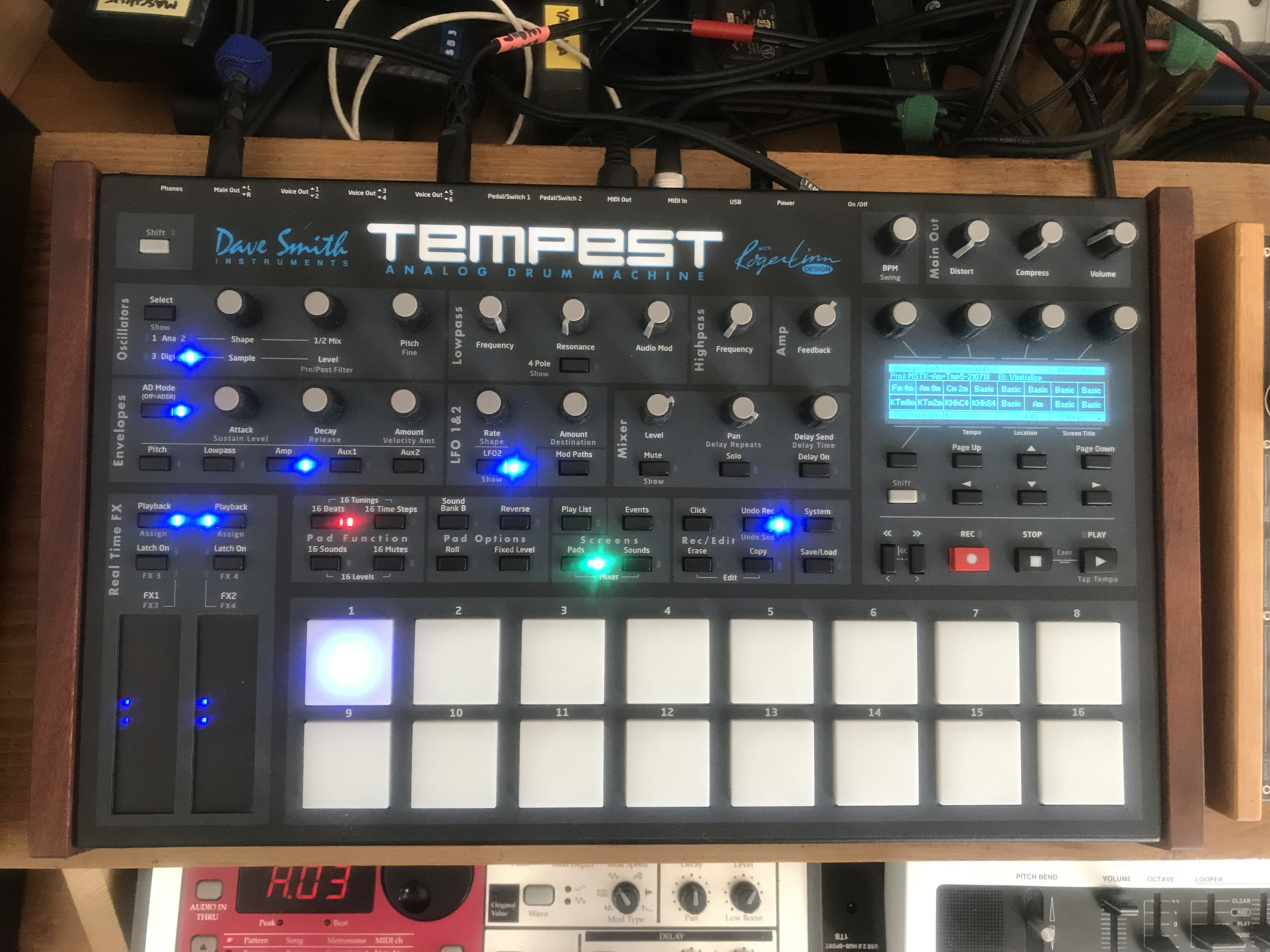
DSI/Roger Linn Tempest
Pros
- 32 sounds (including sound bank B) per beat
- 16 beats per project
- OLED display
- Modulation
- 6 stereo voice outs (!)
- Onboard distortion & compressor (only on stereo outs)
- Beat roll & reverse effects
Cons
- 6 voice polyphony, only plays 6 sounds simultaneously
- Lacking in external MIDI control parameter access
- Saving is a bit tedious…having to scroll thru alphabet with the knobs…
- Internal disk space is very small (I have to delete files to save new ones…)
- Song does not stay in memory through power cycles
The Dave Smith Instruments & Roger Linn Design collaboration on the Tempest 6-voice, analog polysynth and drum machine is one I coveted and lusted after for a while, saving up for, researching & GASSING endlessly (for those who don’t know yet, the acronym “GAS” stands for “Gear Acquisition Syndrome”…generally associated by feverish research and anxious excitement, maybe some hemming and hawing, comparison shopping, YouTube watching…you get the picture… :)) and bought second-hand on eBay for just over $1000 in Fall of 2019. Being an Electribe 2 user, I was attracted by the Tempest’s color scheme, nice blue-lighted pads & LEDs, OLED, printed knob labels lights and control parameters, too. The list goes on.
I was not expecting to be so affected by the voice count, but this device does feel limited in terms of the number of voices that can play simultaneously. It can only play six (6). The sounds are amazing, punchy, controls and enough modulations for me… even has several modes, each with deep and powerful control paradigms and feature sets.
One really nice aspect of it is the depth of control. Also the second sound bank expands it to 32 sounds per beat (I believe) and then 16 beats per project. Thats a lot (to me). But only being able to play six of them at any time, limits things and forces a creative, or just more focused and … doh! limited way of using the machine. That said, for what it does, it does very robustly.
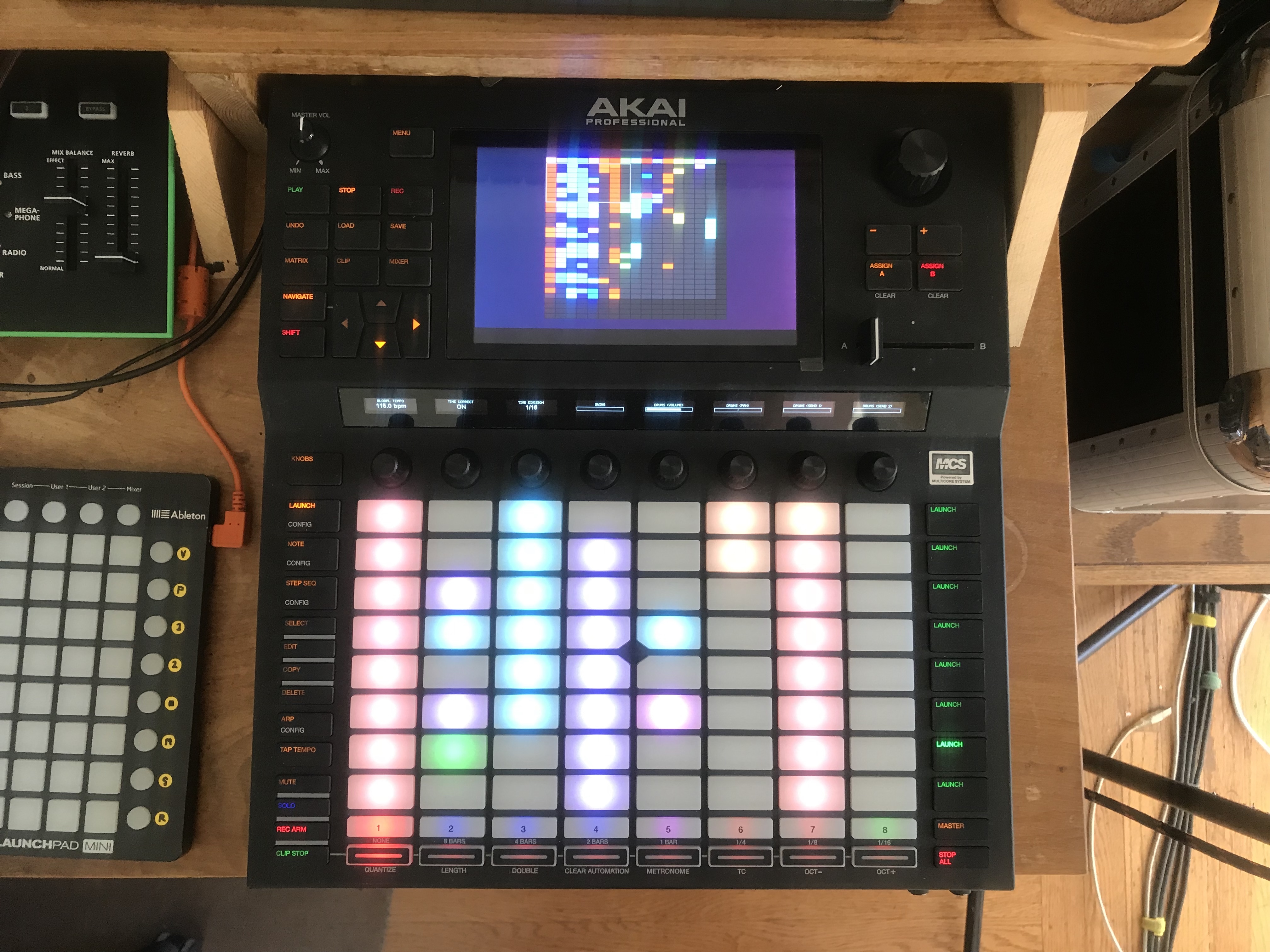
Akai Force
Pros
- AIR Synths & Effects – lots & they sound great
- Drum synth (although only 8 sounds)
- Can have lots of sections (only limited by CPU, I think)
- 7 inch color LCD screen
- See names of tracks, clips, knobs
- Large pad grid, wider pads make for easier finger targeting (than smaller square pads)
- See full names of projects! The larger display makes this easy (within reason)
- Full set overview & lighted pads lighlighting currently playing clips (!)
Cons
- “Only” 1 input
- Not battery powered
- Screen doesnt tilt
- Lights don’t dim that much, screen only blurs
- Only 8 audio tracks
- Only 8 software instrument tracks
- Drum synth is only 8 sounds
- Only 4 mixer inserts
- No VST support
- Song does not stay in memory through power cycles
Ok, next up on the list is the Akai Force. My brother, first raised attention on this one, although due to it’s similarity to Ableton and grid layout, I was also pretty familiar with the workflow as well. In addition, based on the original APC40, which I coveted, but have never owned…and the second-gen APC40 MK2, which I haven’t invested in yet either… When Akai released their standalone Force, it looked like the powerhouse I wanted it to be.
There was a lot of gearlusting. That got me into training videos and explanations of how to use it and so forth. I’ll mention too, that I have a history of setting up Ableton Live sets. Due to my historic lack of an APC40 controller, I’ve created my own systems. As mentioned before I used the Korg Nano (1) series of 3 units to setup an Ableton control system, where the keyboard was actually stepping me through my scenes… But, with this set of units and controls, I was consistently forgetting where I was in my song projects. I mean, I’d be jamming but forget which key I had just pressed, and which section I was in that corresponded to the keyboard. It wasn’t lighted. There was nothing highlighted except a row on my screen but nothing that corresponded where I was actually switching scenes (on the black 2 octave keyboard). I also tried using a Midiman Oxygen 8 but that was also only 2 octaves and not lit for indicating where I was in my Ableton project.
So, the Force was almost a no-brainer. Plus, I had a full-time contract that year, was saving more and felt a bit more able to buy gear. Also, I was practicing in my Trilobyte project and one of my partners has the Pioneer SP1000. It’s a great unit too. Also, fits in the space of a CDJ. Perfect for a club setup! The Force has almost the same size & aspect ratio. But it has more buttons and the onboard AIR soft synths, which are sweet. Sure, the Force has some limitations too. I thought I’d be more hampered by them honestly, from having started with the 16 track RM1X. Maybe it’s because I’ve got some other gear in the mix still… It could be different if I was working only on the Force. Eight audio tracks, eight software synth tracks, 4 mixer inserts per track… But still, you can do much within these parameters. Drum tracks can be separate, used as “sample kits” I’m pretty sure there’s only a CPU limit on this. Which I have run into already. A bit surprising. Not used to being limited by CPU in music gear. But it creates some creative use cases and workarounds too.
Along with having the ability to create drum kits from samples, a recent update has included a new drum synth. Unfortunately this is also only 8 voices. it would be nice to have had a 16 voice drumsynth so it could fill the full lower left quadrant of the units’ pad grid, which is used for the drum samples also.
The onboard synths are dope. The effects are also top notch. I haven’t really explored tons of them outside my normal wheelhouse. But it’s great to have an internal sidechain & compressor combo in the Mother Ducker. Can this work with the new Drumsynth? let me know if so! Otherwise, that’s one chink in it’s otherwise solid offerings.
And it has a visible song arranger mode now which is very similar to a daw. You can set section loops, record performances, automations… You can even go back after the takes and edit notes or curves to your liking. It’s pretty robust. Conveniently, the Force also has an export to Ableton feature which makes it a snap to bring your performances, samples, track arrangements and more into Ableton. Suuuuuper handy!! (Please Synthstrom!)
The 7 inch color touchscreen and 64 pad grid along with 8 endless & capacitive rotary knobs make this a very rich user experience. One of the main reasons i was excited for this was the various displays. To see labels for my samples, patterns, etc. I forgot the knobs have dynamic OLED labels too based on the type of knobsets you want (project, master, screen,…).
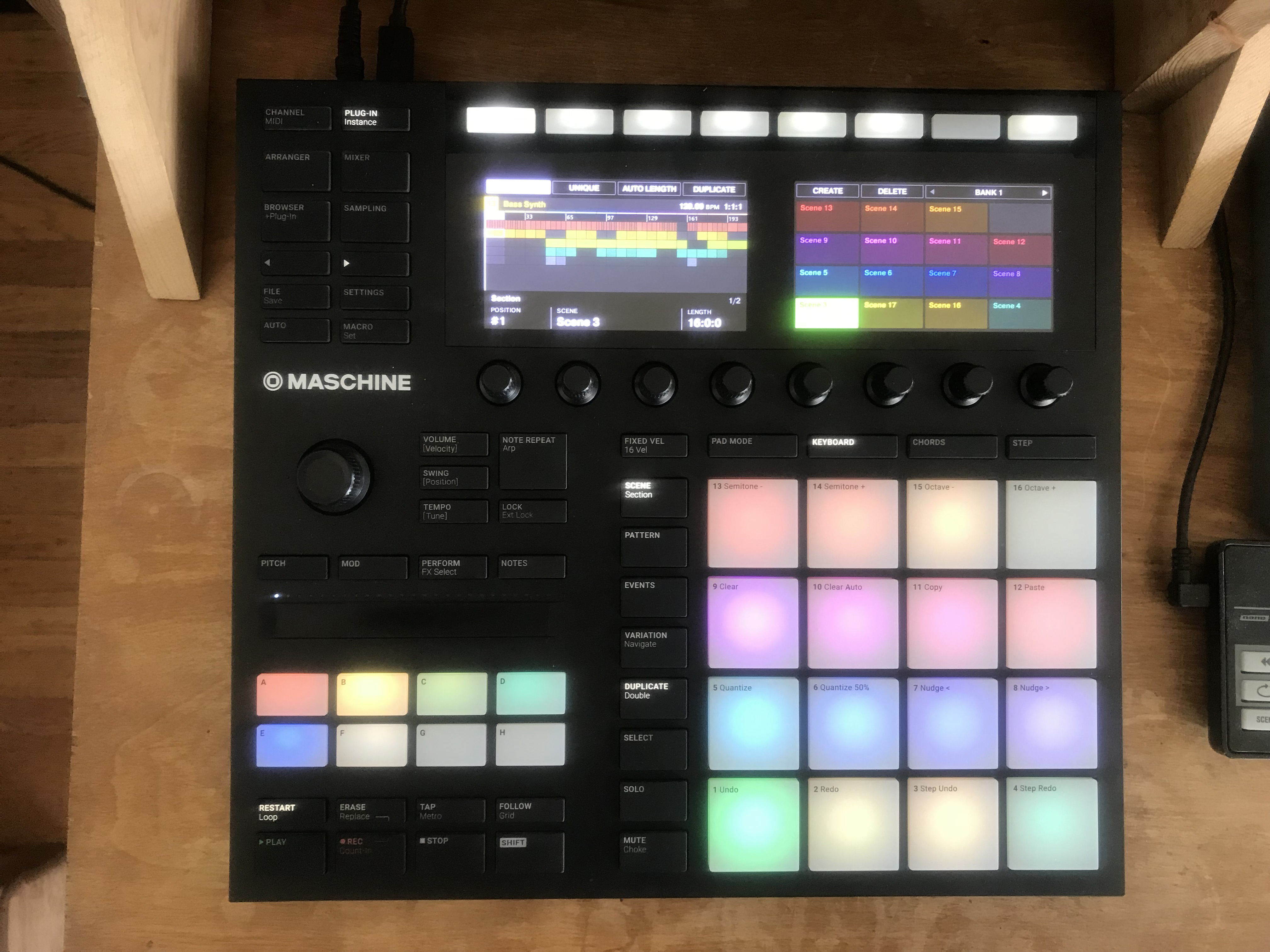
Native Instruments Maschine MK3/+
Pros
- Ability to load many groups of 16 samples
- Nice color screens
- Great pads, biggest & very sensitive (adjustable)
- Perform FX strip
- Morph synced fades between parameter states
Cons
- Only one stereo input
- Only one stereo output
- Not touchscreens
- MK3 is tethered to the computer (+ is standalone)
First, I “only” have the MK3 not the +, so my review will be on the shared feature set. Also, this is in my studio on loan from fellow Trilobyter & studio pal, Scottino – thanks dude!
Also, because its tethered to a DAW, whether its own or another and I’ve been more working on outboard composition and sampling, I’m using this less than my other gear. That said if i need a DAW controller, it does work in some limited form until i get up to Ableton 10+, at which point, I could use my Force, too.
I did just create my first full 16-section project with 5 groups of sounds. In fact I’m probably going to be using that for some game audio I’m working on for Exo. So, it has come in handy. Also, I like the ability to chain sections together into a longer playback cycle. The morph feature is sweet too. Also, the perform effects. Not to mention the sounds.
I think Native Instruments, and Maschine in general, or maybe just the latest libraries from them, are known to have good – no really good sounds. This continues here. The software instruments are great, although the corresponding display could be better. For example, the Force shows the actual plugin with knobs and the UI. Also, it maps the 8 knobs to various sets of modulation options. I really wish the Maschine did something similar with its screens. Currently they’re not very useful, except where the numerical values (and parameter labels) display above the knobs. They could be much better used in this case. However, I do like the visibility and name-ability of the pads and corresponding bits on the screen, which is great.
Overall, it is a very capable unit, when used with a computer. I would imagine the + is just extra. I mean, it’s kind of what I would want from it. Maybe a few more inputs, but otherwise looks really nice, with the metal chassis, too.
Conclusion
OK, drum roll please…. It’s time for the final verdict!
Well, if you hadn’t guessed it already by seeing the post’s featured image, the Synthstrom Deluge is my favorite overall groovebox. Especially considering the fact that it’s the smallest, has many of the features that some of the bigger units have also, including many more. The Deluge packs the biggest bang for it’s size and on the groovebox scene, it currently sits at the center of my studio and has become integral to my workflow and compositional process. The fact that I can take it with me wherever I go, because it’s small enough and battery powered… Also the fact that it has it’s own speaker (not reeeeeally that useful) and it’s own internal microphone (by contrast, actually suuuuper useful!) make it a real go-to device. I can take it from my desk to my table, to my couch, to my deck, to my friend’s place…fit it in my backpack, power it by USB or internal battery…
On top of that, its arrangement features and overall synthesizer and sampling options, modulation and shortcut parameters…and the sound sets themselves are super functional go-to kits. Recognizable starting points for known kits like 808, 909, etc… and you can tweak and effect the sounds. Well, I gushed a bunch over it in the section above, so I’ll keep this shorter.
Suffice it to say, that if I have any recommendation to make to anyone researching a groovebox purchase or decision, I can heartily say that the Deluge is a fantastic option that will take you in so many directions and keep on giving. Do it. Get one and learn it. You won’t regret it.

Note, I do not get any kind of kick-backs for this recommendation. I’m not an affiliate…yet! Reach out if you’re interested Synthstrom!


